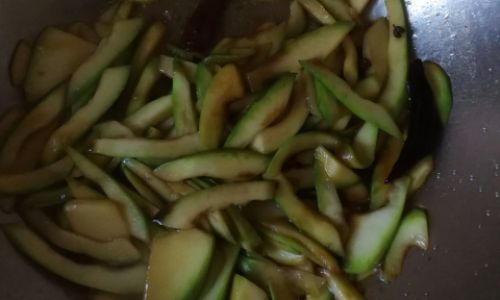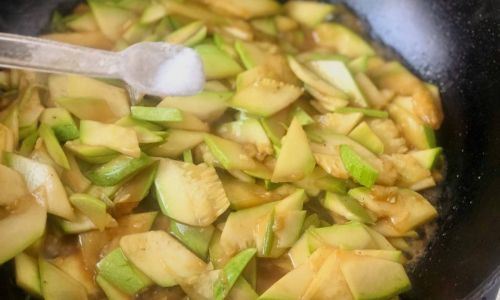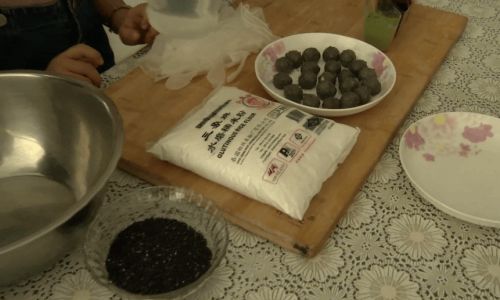Introduction
Vinegar-stir-fried zucchini, or Cu Liu Xi Hu Lu in Chinese cuisine, is a dish that marries simplicity with explosive flavor. Crisp zucchini slices, tossed in a glossy, tangy sauce, offer a refreshing contrast to heavier meals. This dish is beloved for its quick cooking time, minimal ingredients, and ability to adapt to personal tastes. Whether you’re a seasoned home cook or a novice in the kitchen, mastering this recipe will reward you with a versatile side dish that pairs beautifully with rice, noodles, or grilled proteins. In this guide, we’ll explore the nuances of selecting ingredients, perfecting cooking techniques, and elevating this humble vegetable into a culinary star.

Understanding the Dish’s Appeal
Zucchini’s mild, slightly sweet flavor provides the perfect canvas for bold seasonings. The vinegar-based sauce—a blend of tangy, savory, and subtle sweetness—cuts through the vegetable’s natural moisture, creating a harmonious balance. Unlike deep-fried or heavily sauced dishes, this stir-fry retains the zucchini’s vibrant color and crisp texture, making it visually appealing and nutritious. The dish’s appeal also lies in its adaptability: adjust the spice level, swap vinegars, or add proteins like shrimp or tofu to suit your palate.
Key Ingredients and Their Roles
To achieve restaurant-quality results, every ingredient must be chosen and prepared with care:
- Zucchini: Opt for firm, small to medium zucchinis with glossy skin. Larger ones may be watery and less flavorful. Slice them uniformly (about ¼-inch thick) to ensure even cooking.
- Vinegar: The star of the sauce. Chinese black vinegar adds depth, while rice vinegar offers a cleaner acidity. Apple cider vinegar can substitute for a milder tang.
- Aromatics: Fresh garlic and ginger, minced or thinly sliced, form the flavor base. Their pungency mellows during cooking, leaving a fragrant undertone.
- Chili: Dried red chili flakes or fresh birds-eye chilies introduce heat. Adjust quantities based on spice tolerance.
- Soy Sauce: Light soy sauce contributes saltiness and umami. Dark soy sauce adds color but can overpower the dish’s subtlety.
- Sugar: A pinch balances the vinegar’s acidity. Use white, brown, or even honey for complexity.
- Cornstarch: Thickens the sauce, ensuring it clings to the zucchini without becoming gloppy.
- Oil: A neutral oil like peanut or vegetable oil withstands high heat. Sesame oil, added at the end, imparts a nutty aroma.
Preparation: The Foundation of Flavor
-
Washing and Slicing:
- Rinse zucchinis under cold water, scrubbing gently to remove dirt. Trim the ends.
- Slice diagonally into oval shapes. This method increases surface area for better sauce absorption and creates an elegant presentation.
-
Marinating (Optional):
Toss zucchini slices with a pinch of salt and let sit for 10 minutes. This draws out excess moisture, preventing sogginess. Rinse and pat dry before cooking.
-
Sauce Preparation:
In a bowl, whisk together vinegar, soy sauce, sugar, cornstarch, and a splash of water. This mixture streamlines cooking and prevents over-seasoning.
The Cooking Process: Precision and Speed
Stir-frying demands attention to detail. Follow these steps for perfection:
-
Heating the Wok:
Place a carbon-steel or cast-iron wok over high heat. Allow it to smoke slightly—this ensures a non-stick surface and sears ingredients quickly.
-
Aromatics First:
Add oil, swirl to coat the wok, then toss in garlic, ginger, and chilies. Stir-fry for 10–15 seconds until fragrant but not browned.
-
Zucchini Addition:
Introduce the zucchini slices. Use a metal spatula to toss continuously, ensuring each piece contacts the hot wok. Avoid overcrowding; cook in batches if necessary.

-
Sauce Integration:
Once the zucchini brightens in color (2–3 minutes), pour in the pre-mixed sauce. Toss vigorously to coat evenly. The cornstarch will thicken the sauce within 30 seconds.
-
Finishing Touches:
Remove from heat immediately to prevent overcooking. Drizzle with sesame oil and sprinkle with white pepper for aromatic depth.
Tips for Achieving Textural Perfection
- High Heat is Non-Negotiable: Low heat steams the zucchini, resulting in mushiness. Maintain a blazing wok for that coveted wok hei (breath of the wok).
- Timing is Key: Overcooked zucchini loses its crunch. Test doneness by piercing a slice with a knife—it should meet slight resistance.
- Uniform Slicing: Uneven pieces cook irregularly, leading to a mix of raw and overdone textures.
- Adjust Seasoning Judiciously: Taste the sauce before adding it to the wok. Vinegar intensity varies by brand, so start with less and increase gradually.
Variations to Explore
- Vegetable Medley: Add bell peppers, carrots, or mushrooms for color and texture contrast.
- Protein Boost: Toss in cooked shrimp, tofu cubes, or sliced chicken during the final minute of cooking.
- Spice Levels: For a mild version, omit chilies and add a pinch of paprika. For fiery heat, use Sichuan peppercorns.
- Regional Twists: Substitute black vinegar with balsamic for an Italian-inspired dish, or add a splash of oyster sauce for umami richness.
Serving Suggestions
- As a Side Dish: Pair with steamed jasmine rice or egg noodles for a balanced meal.
- In Bowls: Layer over quinoa or brown rice with a soft-boiled egg for a nourishing lunch.
- At Potlucks: Serve chilled with a garnish of toasted sesame seeds—it’s equally delicious at room temperature.
Health Benefits: More Than Just Flavor
Zucchini is a nutritional powerhouse, low in calories but rich in vitamin C, potassium, and antioxidants. The vinegar in the sauce aids digestion and may help regulate blood sugar levels. This dish is gluten-free (use tamari instead of soy sauce) and vegan-friendly, catering to diverse dietary needs.
Common Mistakes and How to Avoid Them
-
Soggy Zucchini:
- Cause: Overcrowding the wok or adding the sauce too early.
- Fix: Cook in batches and ensure the wok is screaming hot before adding the sauce.
-
Bland Flavor:
- Cause: Under-seasoning or using stale vinegar.
- Fix: Taste and adjust seasonings post-cooking. Store vinegar in a cool, dark place.
-
Burnt Aromatics:
- Cause: Cooking garlic/ginger too long.
- Fix: Stir-fry until just fragrant, not browned.
Conclusion: The Joy of Simplicity
Vinegar-stir-fried zucchini exemplifies how minimalism can yield maximum flavor. By mastering the balance of tang, heat, and crispness, you transform a humble vegetable into a dish that steals the spotlight. Experiment with vinegars, spices, and accompaniments to make it uniquely yours. Whether served at a family dinner or a casual gathering, this recipe promises to delight with its vibrant taste and effortless elegance. So grab your wok, sharpen your knife, and let the sizzle of stir-fried zucchini become a staple in your culinary repertoire.






0 comments